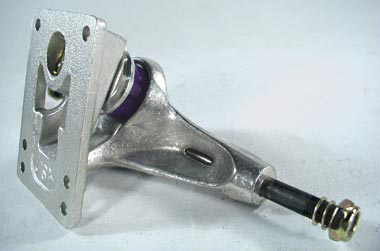

|
Construction The actual board or deck of the skateboard is made of several layers of maple, which is cellulose. The layers are usually laid down so that every other layer is facing a different direction. This helps keep the deck strong and prevent it from breaking under pressure. |
 |
| © www.skateboard.com |
| The layers are glued together and pressed so that they curve up at both ends. The decks are then drilled so that trucks can be screwed on later. Then the deck is cut by hand and sanded. Next at least two layers of polyurethane are added to seal the deck. Finally the decks are screen printed, set aside to dry and then boxed and shipped to skate shops around the world. | |||||
 |
 |
 |
 |
 |
 |
| all photos © www.skateboard.com | |||||
Trucks |
|
 |
Now that our deck is done we can add the other parts. First we need to select our trucks. Trucks are made from cast metal and allow the skater to turn the board. They accomplish this by pivoting about the kingpin. The kingpin is a giant bolt running through the middle of the truck. The kingpin has rubber bushings on it that allow for different resistances when pivoting. So the softer the bushing the easier and quicker it is to turn the skateboard. |
| © www.skateboard.com | |
Wheels |
 |
| © www.skateboard.com |
| Skateboard wheels are made from a urethane. This allows the wheel to be firm and durable. Wheels are given ratings based on how hard the urethane is. The durameter of the wheel is how hard or soft that wheel is. |
| A bearing must be inserted between the wheels and the axle of the truck. The bearing controls the speed at which the wheel will spin. |
Grip Tape |
A layer of adhesive sand paper needs to be applied to the top of the deck before attaching the trucks. The grip tape helps give the skater traction while riding and doing tricks. Finally we need to put a plastic spacer between the truck and the deck. The spacer allows the skater to vary the height of the board from the ground |
| Below is a diagram of a skateboard. Roll over the different parts to see what they are. | |
 |
|
| photo © www.skateboard.com |

|
Return to Where are Polymers? |

|
Return to Main Page |